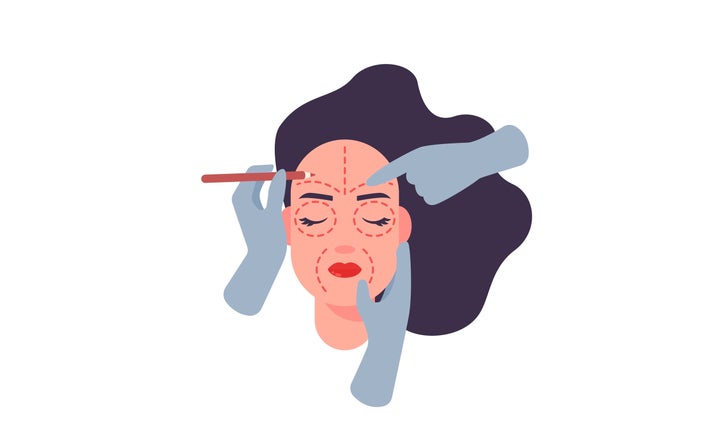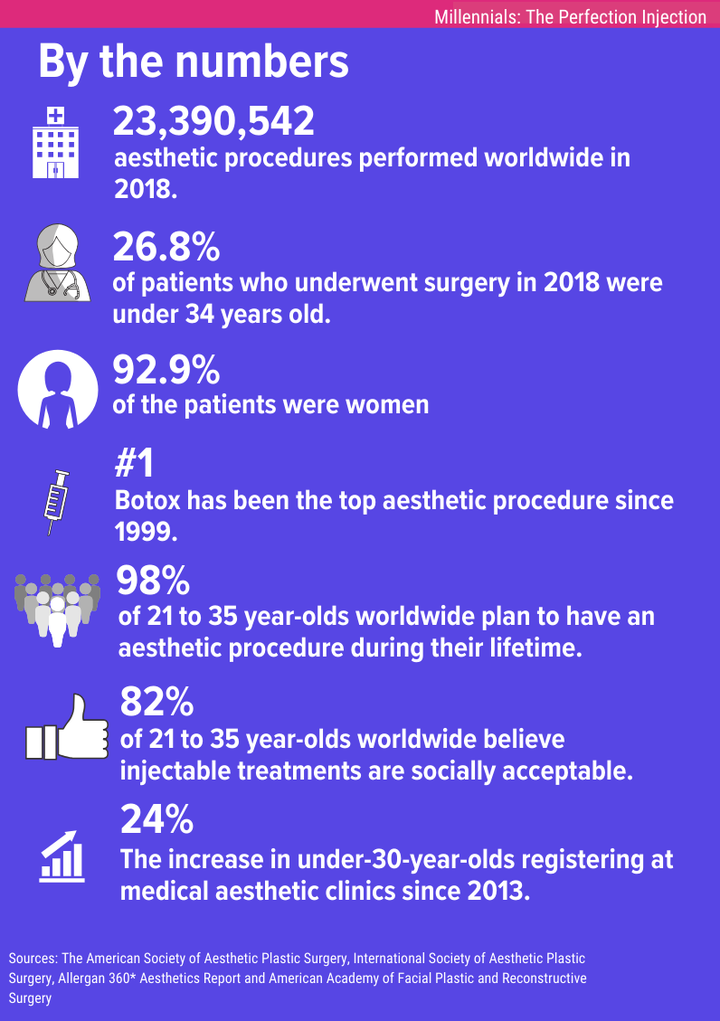
Dark circles, wrinkles, fine lines, thin lips and hook noses are becoming endangered species on the faces of millennials, as 18- to 34-year-olds obsessed with overfiltered ideals appear to have declared all-out war on perceived imperfections.
People under 34 are now having more cosmetic surgery procedures than 51- to 64-year-olds, representing 1 in 4 patients in 2018, according to the American Society of Aesthetic Plastic Surgery, which compiles data provided by surgeons mainly in the United States and Canada.
“When I started out seven years ago, millennials made up 5% of my clients. They now make up at least 30% to 40% of my current clientele, and I wouldn’t be surprised if that figure rises to over 50% in the next five years,” said Dr. Chloé Sylvestre, a general practitioner specializing in cosmetic injections and owner of a cosmetic surgery clinic in Montreal.
What are they obsessed with? An angular, well-defined face and perfect, youthful skin with good elasticity, devoid of any signs of tiredness. The features they desire aren’t necessarily modeled on the celebrities who sing the praises of aesthetic treatments, such as Kylie Jenner and Cardi B; they are actually closer to what their faces look like when revamped by a social media filter.
In fact, in 2018, 55% of patients showed their surgeon a retouched selfie when discussing their aesthetic goals, according to a study by the American Academy of Facial Plastic and Reconstructive Surgery.
“33% of millennials consider treatments to be preventative.”
- Allergan 360° Aesthetics Report
Young people are also flocking to medical aesthetic clinics for preventative reasons. Patients who have seen their parents prematurely develop wrinkles or who exposed themselves to too much sun in their youth are seeking to prevent rather than cure. Many doctors specializing in dermo-aesthetics agree with this logic.
“Millennials, unlike people of our generation, use Botox for preventive purposes, and it makes a lot of sense,” said Dr. Suzanne Gagnon, a dermatologist specializing in aesthetics, referring to people over the age of 65.
“If I see patients coming in who are around 55 to 60 years old, the wrinkles are already established, creased and deep,” added Gagnon, who was one of the first doctors in Quebec to inject botulinum toxin, which is commonly known as Botox. “Even if I inject them with Botox, the deep wrinkles won’t disappear. In young people, they will.”
A World Of Possibilities As Young As 14
It’s not inherently right or wrong for people to start procedures when they’re young, according to the experts HuffPost Quebec interviewed. But, some added, millennials sometimes have very high hopes for what cosmetic work can do.
There is no recommendation from the College of Physicians, an organization for Quebec medical professionals, that dictates the maximum amount of product that can be injected, or what procedures are considered “acceptable” for young people. And under the Civil Code of Quebec, any patient over the age of 14 can have cosmetic procedures without parental authorization, provided that the treatment does not present a serious risk to his or her health. Professionals therefore treat each person on a case-by-case basis, relying on their own judgment.

“We need to explain to very young patients that they should only be coming for a consultation if there is an actual issue,” said plastic surgeon Dr. Benoît LeBlanc. “I frequently refuse treatment that is not necessary.”
Shall I Inject You In My Basement?
If a young patient is refused treatment from a professional, they can try the surgeon next door — or turn to doctors or nurses who travel to different places to do injections, even if they don’t comply with the standards of the College of Physicians.
“I’d imagine that there’s a good percentage of people who do that because it is actually cheaper, because they don’t check the age of the patients, or ask detailed questions about their health,” Sylvestre said. “Unfortunately, there’s probably more people doing it than you’d think.”
A simple search on Facebook, Google or the Canadian classifieds site Kijiji brings up people — trained or not — who are ready to administer injections at people’s homes or at beauty salons.
“Sadly, it happens much more than you think,” LeBlanc said. “Often, when treatments are done in a less professional context, they don’t get great results.”
“Alone in a back room, in a hair salon or whatever, it’s impossible to treat a patient adequately, and they are not providing them with a service; they are only trying to line their pockets,” LeBlanc added. “It can even be dangerous if there are complications. If the injection is done badly, there can be swelling, even tissue necrosis, and worse, it can even lead to blindness if it touches an artery. No treatment is risk-free.”

One man told HuffPost Quebec that he regularly consults a doctor ― whom he did not name — who illegally injects him with Botox at his home, a private condo in Old Montreal. Why does the man, a 29-year-old who asked to be identified as “Simon,” do it that way, despite the potential dangers? Because it’s cheaper. He said he hasn’t experienced any problems so far. “I met [the doctor] through a friend. She also goes to him. I researched his profile on the College of Physicians. He had no complaints against him, and I saw that he was highly qualified,” Simon said.
“As he has no advertising costs, no commercial space to rent or secretary to pay, it costs me less,” said Simon, adding that he had recommended the services to other friends.
The College of Physicians urges patients to speak out against clinicians practicing illegally. It advises that patients be evaluated by a dermatologist, surgeon or general practitioner trained in aesthetics, that they receive treatment in a specialized clinic where a doctor is present in case of complications, and that they have a follow-up appointment.
But Sylvestre said that doesn’t happen very regularly.
“As long as people don’t experience any complications, they don’t report it,” Sylvestre said. “It’s really when they develop a problem that they say to themselves, ‘Ah, maybe the place I’m going to doesn’t meet the standards, perhaps I should report them.’”
In addition to cosmetic surgeries being on the rise, the number of corrective surgeries has doubled since 2017, according to a survey of doctors in the American Academy of Facial Plastic and Reconstructive Surgery. One-third of respondents said they believe this is related to procedures that were performed by untrained people in the first place.
What is...
Botulinum toxin (Botox): This is a purified botulinum protein extracted from a bacteria. Once injected, it freezes the muscles, preventing movement and therefore the formation of expression lines. It can also reduce the appearance of existing wrinkles. However, it can only be injected in certain areas so as not to freeze the muscles that enable expression and articulation. The forehead is the main target area.
Filler injections (or fillers): These are homogeneous injectable gels often based on hyaluronic acid, a sugar produced naturally by the body, which, when combined with the water present in our body, creates dermal volume. It helps reduce wrinkles and redefine certain areas such as the lips, cheekbones or jaw. There are several types of fillers. It is up to the doctor to decide which is most appropriate for the desired correction.
PRP (Platelet-Rich Plasma): This involves stimulating tissue regeneration by injecting plasma from the patient’s own centrifuged blood. The procedure is also known as the Vampire Face-lift. It will also help with hair regrowth.
The Allergan 360 Aesthetics Report, mentioned a few times in this text, is based on responses from 14,500 “aesthetic-minded consumers” (those who have expressed an interest in improving their appearance, and are willing to spend money on it), and over 1,300 doctors in 18 countries.
HuffPost’s “Her Stories” newsletter brings you even more reporting from around the world on the important issues affecting women. Sign up for it here.